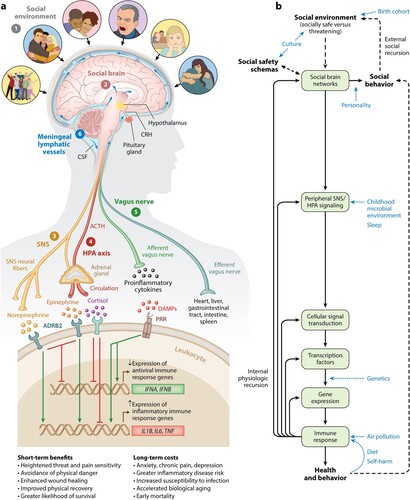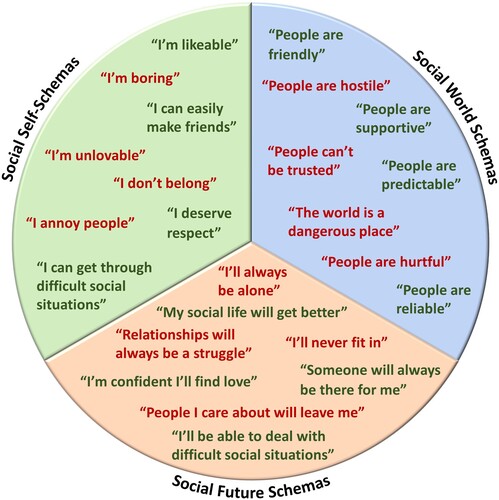Figures & data
Figure 1. Social Safety Theory is grounded in the understanding that the primary purpose of the human brain and immune system is to keep the body biologically and physically safe. To accomplish this challenging task, humans developed a fundamental drive to create and maintain friendly social bonds and to mount anticipatory biobehavioral responses to social, physical, and microbial threats that increased risk for physical injury and infection over the course of evolution. (a) Accordingly, the brain continually monitors the (1) social environment, interprets social signals and behaviors, and judges the extent to which its surroundings are socially safe versus threatening. These appraisals are subserved by the (2) amygdala network, mentalizing network, empathy network, and mirror neuron system (i.e., the social brain). When a potential social threat is perceived, the brain activates a multi-level response that is mediated by several social signal transduction pathways – namely, the (3) SNS, (4) HPA axis, (5) vagus nerve, and (6) meningeal lymphatic vessels. These pathways enable the brain to communicate with the peripheral immune system and vice versa. Whereas the main end products of the SNS (i.e., epinephrine and norepinephrine) suppress transcription of antiviral type I interferon genes (e.g., IFNA, IFNB) and upregulate transcription of proinflammatory immune response genes (e.g., IL1B, IL6, TNF), the main end product of the HPA axis (i.e., cortisol) generally reduces both antiviral and inflammatory gene expression but also can lead to increased inflammatory gene expression under certain physiologic circumstances (e.g., glucocorticoid insensitivity/resistance). The vagus nerve, in turn, plays a putative role in suppressing inflammatory activity, whereas meningeal lymphatic vessels enable immune mediators originating in the CNS to traffic to the periphery, where they can exert systemic effects. (b) This multi-level ‘Biobehavioral Response to Social Threat’ is critical for promoting well-being and survival. However, it can also increase a person’s risk for negative health and behavioral outcomes when it is sustained by internal physiologic or external social recursion. Several factors can also moderate these effects, including birth cohort, culture, personality, childhood microbial environment, sleep, genetics, air pollution, diet, and self-harm. A person’s developmentally derived social safety schemas play a particularly important role in this multi-level response as they shape how social-environmental circumstances are perceived. Indeed, social safety schemas influence neurocognitive dynamics that initiate the full range of downstream biological interactions that ultimately affect disease risk and human behavior. Abbreviations: ACTH, adrenocorticotropin hormone; ADRB2, β2-adrenergic receptor; CNS, central nervous system; CRH, corticotropin-releasing hormone; CSF, cerebrospinal fluid; DAMPs, damage-associated molecular patterns; HPA, hypothalamic–pituitary–adrenal; PRR, pattern recognition receptor; SNS, sympathetic nervous system. Adapted and republished from Slavich (Citation2020a), with permission from Annual Reviews.

Table 1. Examples of socially safe and socially threatening situations, and perceived social safety and social threat. Adapted from Diamond & Alley (Citation2022) to reflect general population experiences.
Figure 2. Examples of socially safe and socially threatening beliefs, organized by the three main types of social safety schemas.

Table 2. Comparing Social Safety Theory and related frameworks.
Figure 3. Individuals are embedded in a variety of social safety circles that determine their moment-to-moment and lifelong experiences of social safety and social threat. These social networks directly affect human health and behavior by influencing the extent to which people experience social safety (e.g., strong family cohesion, welcoming neighbors, inclusive public policy) and social threat (e.g., family conflict, hostile neighbors, divisive public policy). In addition, these networks indirectly affect health and behavior by exposing individuals to construals, messages, and meanings that shape their social safety schemas, which in turn influence their perceptions of the surrounding environment as being socially safe versus threatening. Strategies for promoting social safety can target any of these circles to promote social safety and reduce social threat as a means of enhancing human health, resilience, and behavior. Republished from Slavich (Citation2020a), with permission from Annual Reviews.

Table 3. Individual and collective strategies for promoting social safety and reducing social threat.
